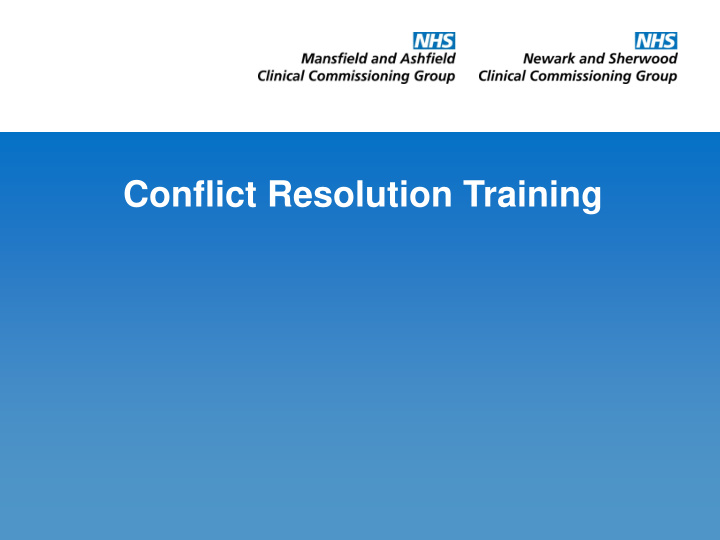



Conflict Resolution Training
Why do we need Conflict Resolution training? 1. Legislation - Health and Safety at Work Act 1974, a working environment that is, safe, without risks to health, and adequate facilities and arrangements for their welfare at work, including training 2. The NHS environment - specific risks of violence against staff are determined by factors such as: Situational – accident and emergency unit, mental health trusts Clinical conditions – renal units, head injury units, mental health and learning disabilities and dementia Lone working – community-based nursing services.
What is Conflict Resolution? • Conflict Resolution is a major concern within the NHS • 63,199 reported physical assaults against NHS staff in England in 2012/13 • It is essential that all staff feel safe whilst at work • Violent behaviour can have a harmful effect on staff • In terms of tackling violence against staff, conflict resolution training is a significant preventative measure • Conflict arises from differing needs • Common in any workplace • Conflict is inevitable, but the key is effective conflict management.
NHS Protect • NHS Protect leads on a wide portfolio of work to protect NHS staff and resources from crime • It has national responsibility for tackling the following areas: 1. Fraud 2. Violence 3. Bribery 4. Corruption 5. Criminal damage 6. Theft 7. Other unlawful action such as market-fixing.
Common causes of conflict Causes of conflict can come about because of: • Unreasonable demands and expectations by patients, colleagues and managers • A perceived poor level of service or difficulty in accessing services • Long waiting times and delays in service provision • Under the influence of drink or drugs influencing their behaviour which can quickly lead to an escalation of conflict • Mental illness.
What is Assault? 1. Physical assault the intentional application of force to the person, without lawful justification, resulting in physical injury or personal discomfort 2. Non-physical assault is the use of inappropriate words or behaviour causing distress and / or constituting harassment. Other related definitions are: Violence : Incidents where staff are abused, threatened • or assaulted in circumstances related to their work, involving a challenge to their safety, well-being, or health • Aggression : Any behaviour that is perceived by the victim as being deliberately harmful or damaging either psychologically or physically.
Body language to avoid conflict • It is a key part of good communication • We can use our body language to build rapport and reduce conflict • We can listen to their reply and use our body language to build a rapport with them Follow the tips below: Keep your body relaxed and open Use open hand gestures Breathe deeply and calmly Respect the other person’s personal space Do not make sudden movements.
What happens if there's a conflict? At this stage we need to consider what to do when conflict has occurred: 1. Assess - Are they angry or frustrated or under the influence of alcohol or drugs? 2. Identify trigger factors - What do they want or need? 3. Reassure to reduce anxiety. Explain what you will do but do not make promises 4. Talk / listen - Speak to them calmly and actively listen to them, empathise and check your understanding. 5. Problem solving - Explain what you will do, when you will do it and how you will keep them informed of progress.
Reasonable force • You have a right to self-defence under UK law • You may exercise the “minimum force” necessary to defend yourself • Anyone can use “reasonable” force to protect themselves or others and not face prosecution as long as they act “honestly and instinctively” in the heat of the moment.
Personal safety DO NOTs Do not: • Show hostility • Use provocative language • Show signs of irritation • Adopt a ‘square-on’ stance • Behave in an overly authoritative manner • Give an ultimatum unless you are prepared and able to follow it through.
Personal safety DOs • Be prepared for problems • Avoid behaviour that is likely to provoke • Keep calm and do not raise your voice • Be respectful and tolerant • Remember that silence can be helpful • Listen and try to understand • Get help if you fear that violence is likely or the situation is liable to escalate.
Remember • It is in your best interest to avoid conflict whenever possible • The use of appropriate inter-personal skills in any potentially difficult situation will help towards this end • In any conflict situation use your common sense, rely on your experience but also tailor your response to the situation • If your gut instinct tells you a situation is escalating out of control, listen to it, walk away and seek help.
Incident Reporting • If you have felt in any way that conflicts have affected you please complete an incident form on Datix • Datix Incident Reporting : http://ns- datix/datix/live/index.php • If you require confidential support or feel that occupational health services may be of benefit, they can be contacted via: http://gemocchealth.co.uk/.
Recommend
More recommend